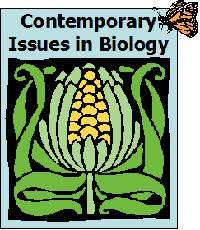
Week 12, Chapter 9 -- Adopt-a-Species Sample Assignment
Course home | Weekly schedule | Announcements | Instructor Info | Desire2Learn | MasteringBiology® | Honor Code | FAQs | HELP!
 |
Week 12, Chapter 9 -- Adopt-a-Species Sample AssignmentCourse home | Weekly schedule | Announcements | Instructor Info | Desire2Learn | MasteringBiology® | Honor Code | FAQs | HELP! |
Report #1: To the Society for the Conservation of the Kanab Ambersnail:
Thank you for your interest in conserving the Kanab Ambersnail (Oxyloma haydeni kanabensis). As you know, the snail is endangered mostly because of the loss of the wetlands where it lives in small areas of Colorado, Utah, and Arizona. However, according to the Arizona Game and Fish department, part of the Kanab ambersnail recovery plan is a captive breeding program. So far, limited studies have shown that the captive bred snails successfully reproduce after release.
DNA fingerprinting studies would help scientists determine the long term success of the captive breeding and release program. One model could be the ruffed lemur project that we have recently learned about. In that project, scientists are comparing DNA from zoo-bred lemurs to wild-caught lemurs “to track how the ‘zoo lemurs’ are adjusting to their new habitat over time.”
I suggest a study in which DNA is removed from a random sample of captive-bred snails and snails caught in the habitat to which the captive-bred snails will be released. (I trust the scientists can find a way to take a DNA sample without killing the snails, perhaps by collecting cells from the snails' slime trails). Technicians will then cut the DNA with restriction enzymes that recognize specific DNA sequences. After running the cut DNA through a gel that sorts the fragments by size, a radioactive probe will indicate whether there are differences in sequences between the wild-caught and captive-bred snails.
I suggest doing this DNA analysis at the start of the release program. Then, after a few breeding seasons, scientists could collect more snails from the habitat. They could then repeat the DNA analysis and determine the relative abundance of alleles specific to the wild-caught and captive-bred populations. If “captive-bred alleles” have become more common, we will know that the breeding program was a success. If not, we will have to reevaluate whether captive breeding will help this species or if we need to consider alternatives.
Report #2: To the Society for the Genetic Modification of the Kanab Ambersnail:
Thank you for your interest in genetically engineering the Kanab ambersnail with an eye toward the conservation of the species.
I have recently learned that about 1-10% of Kanab ambersnails are infected with a parasite, a worm called Leucochloridium cyanocittae. Birds transport the parasite from wetland to wetland, but the worms infect only the Kanab ambersnail. Although research in this area is limited, scientists think that infected snails may reproduce less and be more susceptible to predation than uninfected snails. The worm may therefore pose an additional threat to a population already reduced by habitat loss.
It may be possible, however, to genetically modify the snail for resistance to the parasite. The worm that affects the snail is a type of fluke. Humans also suffer from fluke parasites, and much research has been devoted to the mechanisms by which we fight them off. Although I was unable to confirm this, it is possible that we can identify a human gene for fluke resistance that would also work against the snail’s parasite. The Human Genome Project may greatly speed discovery of such genes. (If not, we could turn to closely related snails that are unaffected by the worm and try to determine what mechanisms they use to remain resistant.)
In short, the steps required to genetically engineer a snail with a human gene for fluke resistance would include:
One possible environmental impact that may result from this type of genetic modification stems from the possibility that worm-infected snails are more susceptible to predation than uninfected snails. Therefore, the release of genetically modified, fluke-resistant snails might reduce snail predator populations by depriving them of food.
If other, closely related snails somehow obtained the modified gene, the environmental concern I just mentioned might be amplified. Presumably, the animals that eat the Kanab ambersnail also eat its close relatives. If all became more resistant to flukes and therefore less susceptible to predation, their predators might have less to eat, and their populations might suffer. Or, they might turn to other food sources and deplete those populations instead. Either way, spread of the gene might have ripple effects on the wetland food chain.
[788 words before references]
References:
Arizona Game and Fish. 2003. Kanab Ambersnail. http://www.gf.state.az.us/w_c/nongame_kanab_ambersnail.shtml. Downloaded July 24, 2004.
Wyner, Yael. Undated. What's black and white and fluffy all over? http://www.ology.amnh.org/genetics/aroundtheworld/pages/lemur.html. Downloaded July 24, 2004.